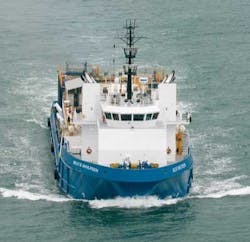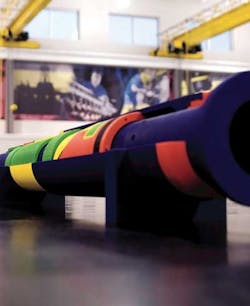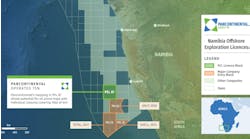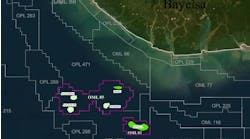Pramod Kulkarni - Contributing Editor
Just as the voyagers of the science fiction Starship Enterprise probed the outer reaches of space to reveal new worlds, oil and gas exploration teams, working in the real world, have boldly gone where no one has gone before to discover giant fields in the deepest reaches of the Gulf of Mexico. They have taken a peek at billions of barrels of potential reserves. There are no Klingons to battle, but the operators and service companies will have to deploy next-generation technologies, some still in design and development, to overcome the greatest risks the industry has encountered to date. The technology challenges include extreme water and target depths, seismically dense salt canopy, low-porosity and low-permeability reservoirs, and high-pressure/high-temperature (HP/HT) downhole conditions.
Giant discoveries across the Gulf
Exploration in the GoM has progressed along a series of frontiers. First were the “bright spot” amplitude plays on the shelf. Then came the salt-flank plays on the slope, which now contribute an increasing share of the GoM production through mini-basin fields. While discoveries are continuing to be made in the Upper Tertiary (Miocene) sequences, the new frontier has shifted to the deepest, oldest rocks of the Lower Tertiary. More than a dozen major discoveries announced thus far have shown the Lower Tertiary play to be continuous across deepwater GoM from the Alaminos Canyon in the Western Gulf (Trident and Great White discoveries) to Walker Ridge in the Central Gulf (Cascade and Chinook). In the middle are the latest discoveries: Jack 2 in Walker Ridge and Kaskida and Tiber in Keathley Canyon.
“The Lower Tertiary play could be as wide as 300 mi (483 km) and involve as many as 3,000 blocks,” according to the Minerals Management Service (MMS) Gulf of Mexico Regional Director Lars Herbst. The first production from the Perdido Regional Development Hub, encompassing the Great White, Silvertip, and Tobago fields, is expected in early 2010.
Potential reserves in billions
Potential reserve estimates for the Lower Tertiary play vary wildly from 3 to 15 Bboe because much of the play remains untested. A better gauge of value can be discerned from the capacity of some of the production facilities currently under construction or in engineering design. For example, Shell is heading toward production at the Perdido spar with a capacity of 130,000 boe/d. Chevron is conducting front-end engineering and design (FEED) for a joint production facility for its Lower Tertiary Jack and St. Malo fields at a capacity of 120,000 to 150,000 boe/d initially, with expansion capacity to greater than 200,000 boe/d. George Kirkland, Chevron’s executive vice president for Upstream and Gas, reports that the two fields have “recoverable resources in excess of 500 MMbbl.” Without revealing specific test results for its Tiber and Kaskida discoveries, BP identifies the fields as giants. “We’re excited by the resource potential that we see in Kaskida that puts it in the same league as the Tiber field,” says Andy Inglis, CEO of BP’s exploration and production segment.
Greatest risks
Some operators working the Lower Tertiary lean toward a measured approach. George Gustavo Amaral, Petrobras America’s Upstream senior vice president in charge of Gulf of Mexico operations which include Chinook and Cascade fields, cautions, “The statistics tell us there is a lot of oil left in the Gulf of Mexico, but there are challenges. The key for the success in the ultra deep Lower Tertiary plays is how the wells behave.”
In the exploration phase itself, the giant discoveries have to be balanced against the cost of dry holes. For example, Chevron drilled four dry holes prior to its Buckskin discovery, each at a cost of more than $100 million per well, according to Gary Luquette, president of Chevron’s North American Exploration and Production group.
Seeing through the salt
While seismic advances such as prestack depth migration have been crucial prerequisites to drill the Lower Tertiary discovery wells, the presence of a thick Louann allochthonous salt canopy makes it difficult to generate a clear subsalt image. Through the integration of seismic, gravity, and magnetic data, geoscientists at Fugro have created a new basement map.
“With this new surface, it has been possible to carry out detailed quantitative 2D and 3D earth modeling,” say Alex Blacque and Rao Yalamanchili. “Results using the new integrated 3D modeling demonstrate that salt-cored antiforms have been predicted beneath 90% of the drilled subsalt Wilcox wells. Creating a deep allochthonous salt isopach has identified many other structures.”
Improved imaging is also possible through the acquisition and processing of wide-azimuth 3D seismic data. Wide-azimuth surveys enable significant improvements in imaging by better illuminating complex geologic features, increasing the signal-to-noise ratio, and allowing better attenuation of multiples. WesternGeco announced plans in October 2009 to acquire a multi-client wide-azimuth Q-Marine survey in the Alaminos Canyon, Keathley Canyon, and East Breaks areas. The data processing techniques include 3D GSMP generalized surface multiple prediction and anisotropic Reverse Time Migration (RTM). WesternGeco also began acquisition of the E-Octopus VII survey in November 2009. Located in the Walker Ridge and Keathley Canyon areas of the US Central GoM, the E-Octopus multi-client wide-azimuth survey covers approximately 300 outer continental shelf (OCS) blocks. In 2007, CGGVeritas had conducted a wide-azimuth survey over the Walker Ridge area after the discovery of the Jack 2 field.
Solutions for high cost delivery and tripping
Tripping costs are high as are costs to deliver equipment and materials 150 to 250 mi (241 to 402 km) from the supply depots on the coast. As such, equipment reliability and failsafe operations are key requirements. Tripping has to be minimized through one-trip solutions. At 25,000 ft (7,620 m) into the hole, tripping takes two to three days at a rig cost that can exceed $500,000 a day.
Drilling through the salt
The subsalt nature of the Lower Tertiary plays requires careful planning of salt entry and exit strategies in the face of limited knowledge of fracture gradients, low-pressure rubble zones, and/or high-pressure sand formations. Well control is a major concern as an unmanageable kick in this environment can lead to recovery cost of as high as $20 million. After exiting a rubble zone, a Lower Tertiary well can encounter highly viscous tar zones that can ball up the bit and the bottomhole assembly, and even foul some surface equipment. Operators and service companies are developing next-generation wellbore models and multi-phase flow simulators to minimize such while-drilling risks.
Redesign for HP/HT extremes
Bottomhole pressure in the Lower Tertiary wells is expected to exceed 20,000 psi (138 MPa) and the temperature to exceed 400° F (204° C). Current technology can accommodate either high pressure or high temperature. With both high pressure and high temperature, the completion equipment has to be redesigned, possibly with new higher strength, low-corrosion metals and elastomers as higher temperature also increases corrosion effects. A similar redesign process is under way for extreme-condition packers and cementing equipment.
Fracturing long pay zones
Typical shelf and Miocene payzones have been 100 ft (30 m) or fewer intervals with shale separation. The Lower Tertiary play is expected to feature long, continuous payzones as long as 300 ft (91 m). As a result, the offshore stimulation contractor may have to adopt multi-zone, single-trip fracturing strategies that have been successful for onshore shale plays. Fracturing fluid has to be denser because the wells will have high fracture gradients. It is necessary to use high-density fluids to reduce surface treating pressures.
“Our customers in the Lower Tertiary play routinely encounter depths below 20,000 ft (6,096 m) and pressures above 20,000 psi, making it is necessary to use high-density fluids for reducing surface treating pressures,” explains Richard Vaclavik, GoM Region vice president, Halliburton. “Due to the nature of the Lower Tertiary’s Wilcox formation, fracture stimulation is required and our high-density fracturing fluid technology is a key enabler for successful treatments.”
Deepwater flow assurance
Hydrate formation is a critical issue for flowlines due to very cold water temperatures. Downhole, innovative solutions will be required to inject inhibitors not just at the tubulars, but also at the perforations below the production packer. In some deepwater completions scale, paraffin, and corrosion inhibitors will have to be pumped with the proppant during fracing operations.
Innovative production
Lower Tertiary operators are going beyond the conventional to reduce the cost of floating production facilities. Shell and its partners will develop the Great White, Tobago, and Silvertip fields via the Perdido Regional Development Host. Perdido has a common processing hub that incorporates both drilling and capabilities to gather, process, and export production. The regional concept is designed to reduce the number of facilities. With Chinook and Cascade 180 mi (290 km) from shore and away from existing production pipeline network, Petrobras is introducing the FPSO concept that it has applied offshore Brazil. Production will be enhanced by subsea booster pumps located downstream from the gathering manifolds. First oil will is scheduled to flow in early 2010.
Is it the final frontier?
In the early 1990s, production in the Gulf was declining. Considering the prospects for elephant fields as dim, some of the operators called the GoM a “dead” sea and looked for hunting grounds elsewhere in the world. Discovery of the Mahogany field in 1995 brought them back to seek production gains in the new Miocene frontier. Subsequently in the early 2000s, few geologists expected to find significant oil traps in the Lower Tertiary. The skeptics have been proven wrong with the discovery of long Lower Tertiary oil pay zones. These discoveries will require development efforts of several decades. Will the operators then discover another frontier beyond the Lower Tertiary in the abyssal depths of greater than 12,000 ft (3,658 m) in the Sigsbee Deep?
Building next-generation technology
The E&P challenges in the Lower Tertiary are being tackled by operators, drilling contractors, and service companies working independently and in technology partnerships.
Ultra deepwater drillships
With five-year drilling contracts from Chevron in hand, Transocean has placed into service two ultra deepwater drillships built to the operator’s specifications. TheDiscoverer Clear Leader began drilling operations in August 2009. The second vessel, Discoverer Inspiration, is scheduled for delivery in early 2010. Both drillships are capable of drilling in 12,000 ft (3,658 m) of water to a total depth of 40,000 ft (12,192 m), exceeding the limitations of existing rigs.
Next-generation reservoir simulation software
In October 2009, Schlumberger and Chevron introduced their INTERSECT reservoir simulation software designed to handle large, complex reservoirs and highly heterogeneous systems that typify Lower Tertiary fields. “By creating key technologies through collaboration, this innovative partnership is delivering next-generation technology that could benefit the energy industry,” says Michael Allison, Reservoir Management general manager, Chevron. The technology collaboration between the two companies began in 2000.
Largest ultra deep stimulation vessel
In October 2009, BJ Services launched the world’s largest stimulation vessel specifically for wells in the Lower Tertiary formations. TheBlue Dolphin provides 20,000 psi pressure rating for Lower Tertiary conditions, including long, multiple pay zones, and intense pressure and temperature variations. “We can essentially have multiple crews working around the clock to provide large-volume, high-pressure stimulation services,” says Ronney Coleman, BJ Services for North American Pressure Pumping Services.
Next-generation completion and production tools
In December 2008, Baker Hughes inaugurated its Center for Technology Innovation (CTI) in Houston. The primary focus of this facility is to develop next-generation completion and production tools for HP/HT conditions typically found in the Lower Tertiary wells. “The CTI is capable of testing full-size prototypes of the next generation of completion and production equipment in a test environment with gas pressure up to 40,000 psi and temperature up to 700° F (371° C),” says Rustom Mody, Baker Hughes vice president of Technology.










